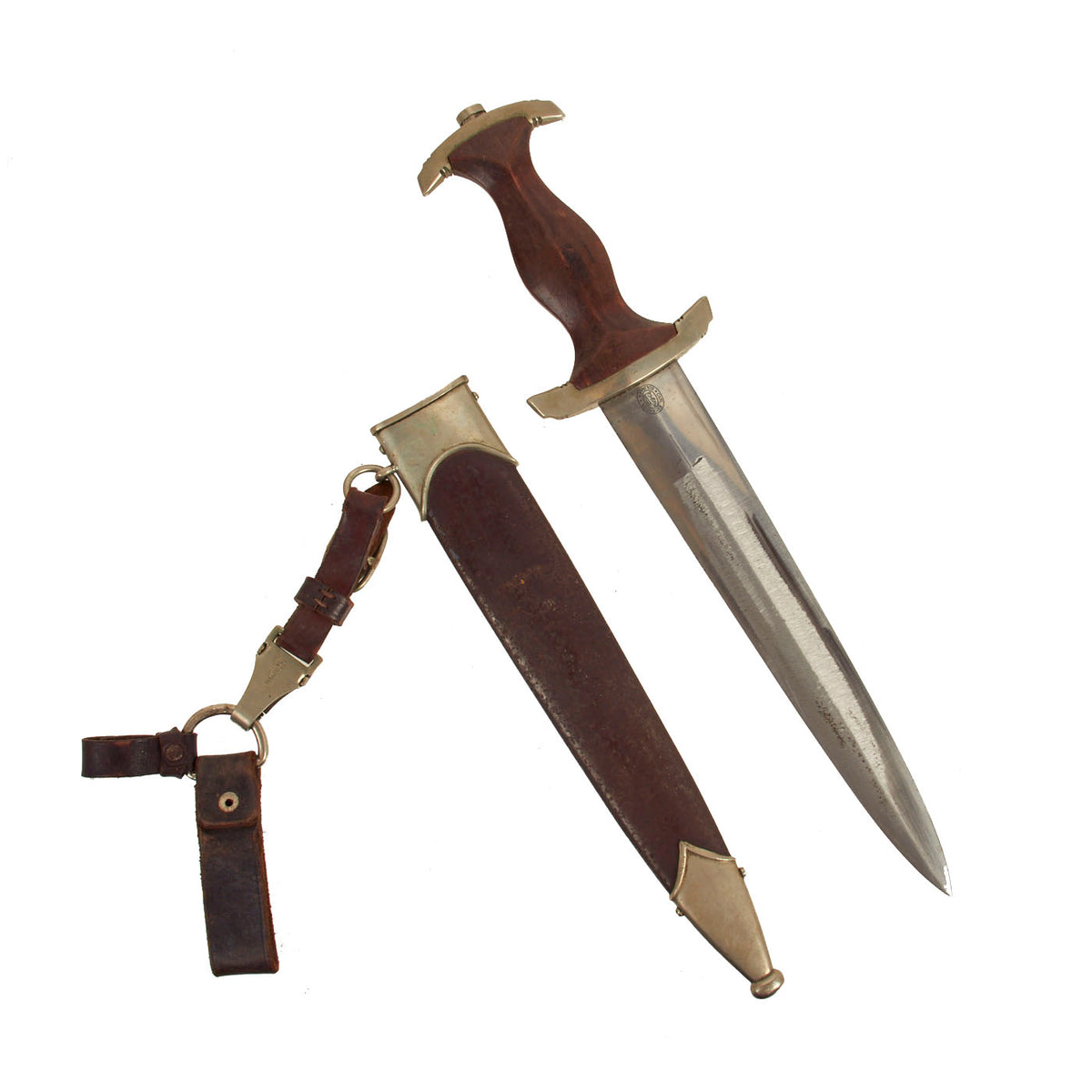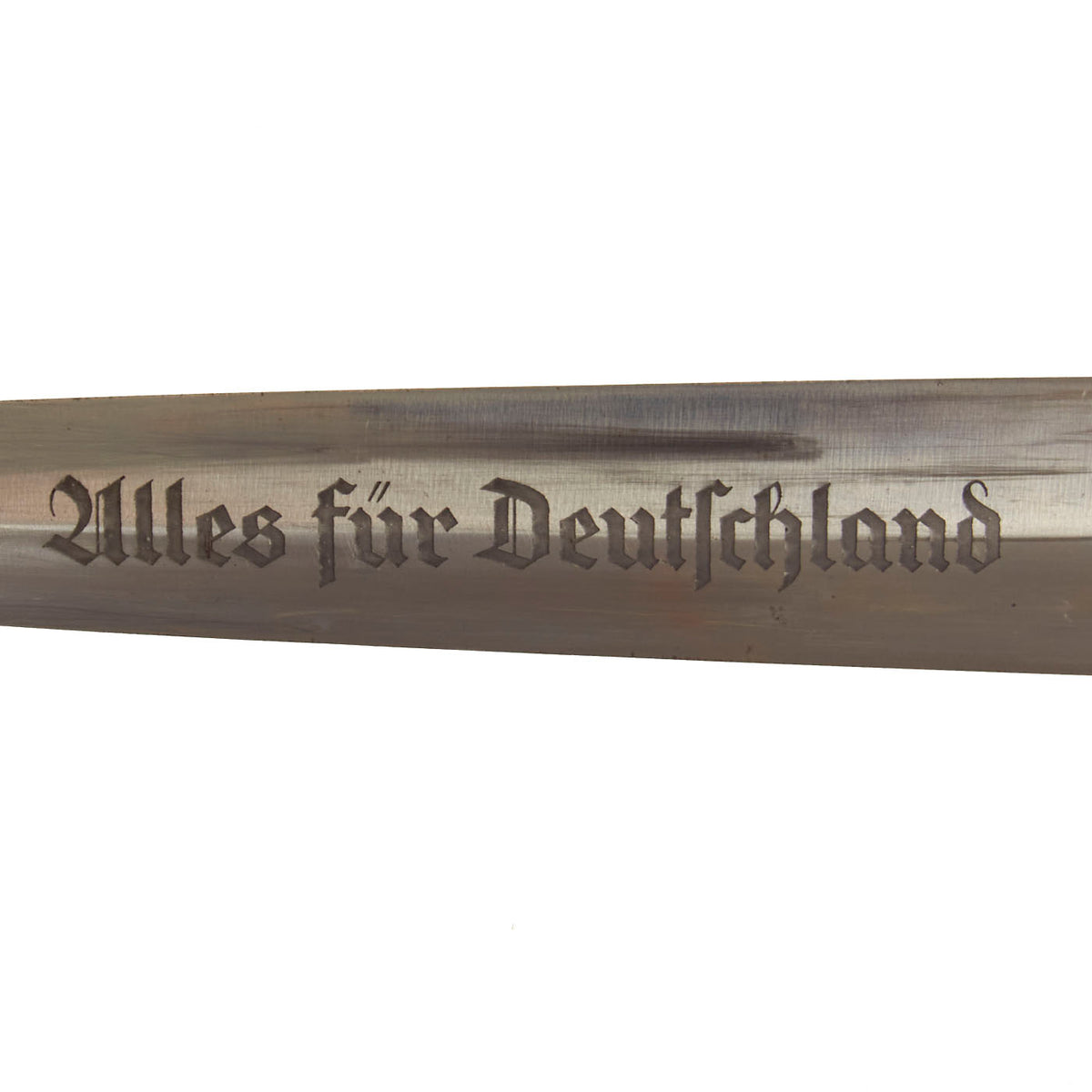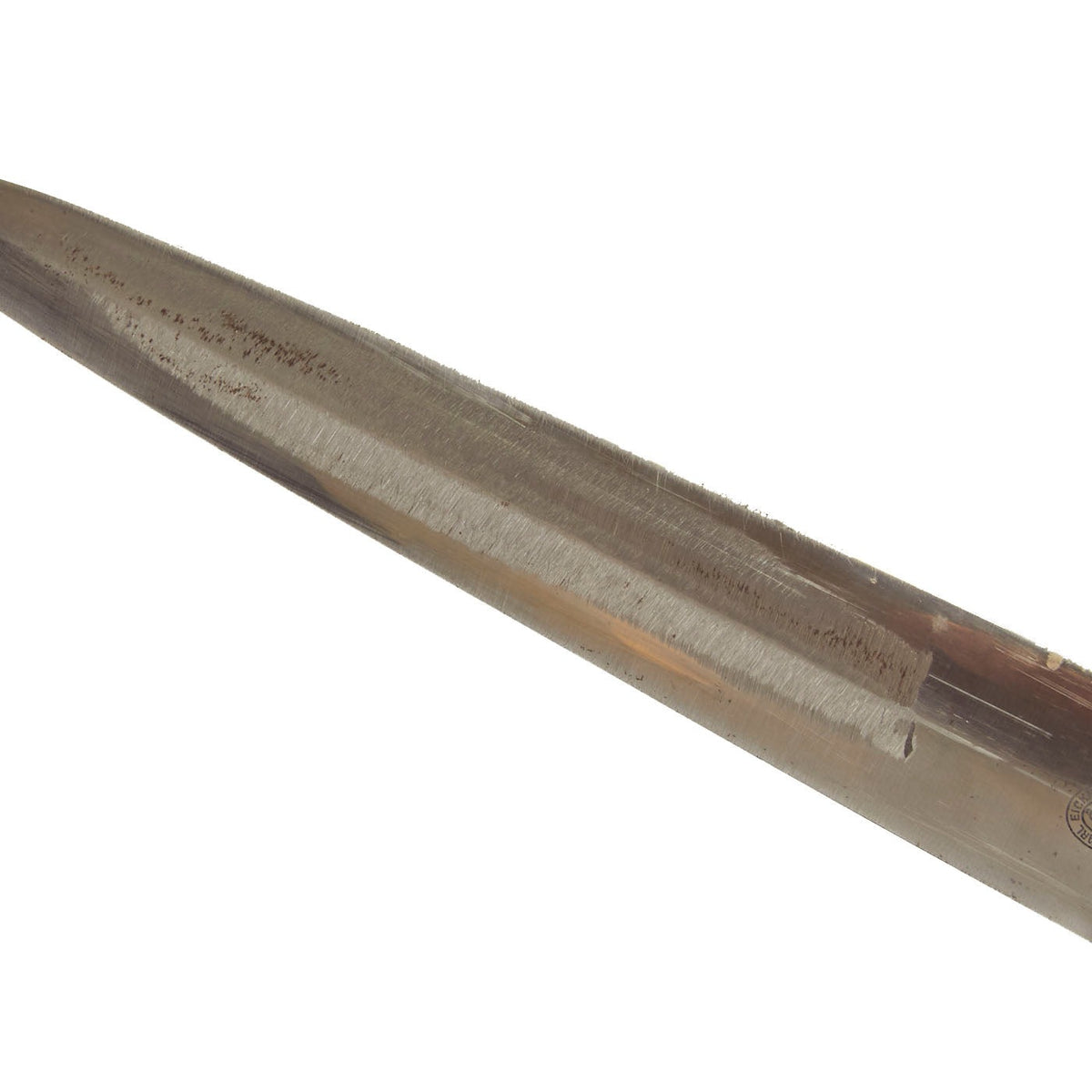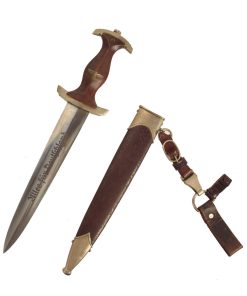Original German WWII Early Ground Röhm Signature SA Dagger by Carl Eickhorn with 3 Piece Hanger & Scabbard Original Items
$ 1.895,00 $ 473,75
Original Item: Only One Available. Prior to his “unmasking” as a traitor, Ernst Röhm was the leader of the Sturmabteilung (SA). In 1934, he distributed approximately 100,000 SA daggers with his personal inscription on the reverse blade. These daggers were to honor individuals who had served with the SA prior to December, 1931. Other than the inscription, these pieces were identical to the standard M1933 SA dagger. After the Röhm purge, the inscription was ordered to be removed, and failure to comply would be considered treason.
Some were simply ground in the field by whatever means were available, such as this example. Other examples were returned to the factory or arsenal for grinding and refinishing. Examples will occasionally be encountered with remnants of the original inscription remaining on the blade, but mostly none will remain. Some blades exist with an intact inscription, exhibiting only the removal of the Röhm signature. Very, very rarely is an example seen with a full, untouched inscription, as the holder would have surely risked a charge of treason.
This is a fantastic Early Ground Röhm Signature SA Dagger, made by the legendary Solingen-Based firm of Carl Eickhorn. The blade is in fantastic condition, and the back still clearly shows the somewhat crude marks left by removing the signature. There is just a bit of the very end of it left, clearly visible by the trademark logo. It comes complete with the original scabbard, as well as a complete three piece leather belt hanger, which are quite rare to find. These have both the belt loop and a securing loop for the handle, which allows the dagger to hang vertically. We have only seen a few of these previously.
The front side of this blade is in excellent condition, with almost all of the factory final grind cross grain still present. This texture is iconic, and is the definitive identifying characteristic for a real WWII German Blade. There is the usual runner wear, and just a bit of scuffing and oxidation speckling. The acid etched Alles für Deutschland motto is beautifully executed, and still retains almost 100% of the original factory darkening, which can still be felt.
The rear also bears much of the original crossgrain, except for an area in the center which has been somewhat crudely ground away, almost certainly in the field, or even at home. We believe this is because it was originally issued with the inscription “In Herzlicher Freundschaft Ernst Röhm” (In heartfelt friendship Ernst Röhm) on the back. The very end of the signature can be seen, with the matte etched finish still present.
The reverse ricasso is etched with a crisp 1933-35 Eickhorn trademark logo: a double oval surrounding a seated squirrel with a notched tail holding a sword, with CARL EICKHORN / SOLINGEN surrounding the squirrel trademark. There are tiny “x” marks between the name and city name. Per J. Anthony Carter’s book GERMAN KNIFE AND SWORD MAKERS, this is one of several similar trademarks used during the period, and is exactly what would have been used on early SA, NSKK, and SS daggers signed by Röhm.
This legendary company was founded in 1865 by Carl Eickhorn, and is arguably the most famous of all Solingen makers. Not only could the family trace their history back 500 years, but they could also demonstrate involvement in the hardening and grinding industries for the same period. Truly the nobility of Solingen Edged weapon dynasties. Eickhorn edged weapons are the most desirable of all makers. They were a known maker of the Röhm daggers, and we have seen other example with this same trademark with much more of the signature intact.
The brown hardwood grip has no chips, cracks or major damage, just the usual wear from age and use. It shows a bit of overall fading from exposure, and it looks like the dagger was stored for a long time with the blade in the scabbard, explaining why the blade looks so good compared to the rest of the dagger. The solid nickel-silver eagle is crisp with a perfect fit, and has some verdigris on it, showing that it is indeed nickel alloy. The SA roundel still retains all of the enamel, however it has has popped out of the grip a bit, and it also is quite oxidized / patinated.
Both guards are solid Nickel alloy, and really in great shape. They have a lovely lightly worn patina, with no flaking or bubbling, showing that they are indeed solid alloy. The pommel nut is present, with just a bit of rounding from tightening. The reverse crossguard is faintly Gruppe/Gau marked Ho, for Hochland (Highlands) a district in the far South German mountains, with the principal city being München (Munich).
The steel scabbard shell is the early-war style, with a brown “anodized” finish on the steel, which was originally covered by a lacquer protective coating. The coating is completely gone now, and there is overall oxidation speckling. There is also a large wide dent near the throat, which does not interfere with sheathing the blade. The upper and lower fittings are solid nickel silver, and have a nice patina, with some dents and scratches showing typical wear. The bottom fitting is dented, typical of the softer alloy, and the retaining screws are both intact and look great. The top mount and throat throat nicely matches the crossguards, with both dome head screws intact.
The attached three piece belt hanger is in good condition, with light wear to the leather and hardware. The nickel spring clip itself is marked with a “barred A” followed by D.R.G.M. (Deutsches Reiches Gebrauchs Musterschutz) – meaning it is a protected patented design under the Reich Government. This design was registered to the owner of the “Barred A” trademark, F. W. Assmann & Söhne of Lüdenscheid, a large maker of belts, buttons, and other accoutrements.
A fantastic early SA dagger with a great blade, made by a Legendary naker and “sanitized” after the Night of the Long Knives! Ready to add to your collection and display!
Specifications:
Blade Length: 8 3/4″
Overall length: 13 3/4”
Crossguard: 3”
Scabbard Length: 10”
The SA or Brown Shirts, were a private political formation which Adolf AH and the NSDAP used to maintain order at organized Party meetings and demonstrations. The group was formed in 1921, and grew to a huge force of nearly 3,000,000 men by the later 1930’s. To instill esprit de corps, as well as create employment for the Blade City of Solingen, it was decided each SA man would carry a dagger with his Brown Shirt uniform. Huge quantities needed to be produced to accommodate the demand. The dagger initially was produced of hand-fitted nickel mounts with attractive finished wood grip and brown anodized (a bluing process) finished scabbard.
The blade was etched with the SA motto, Alles für Deutschland. Examples produced prior to 1935 were stamped with the German sector of the SA group on reverse lower crossguard. Later examples underwent standardization through the RZM ministry. These pieces were produced of cheaper plated zinc-base fittings and scabbards were simply painted brown.
The Night of the Long Knives, in June 1934, saw the wiping out of the SA’s leadership and others who had angered AH in the recent past in NSDAP Germany. After this date, the SS lead by Heinrich Himmler was to become far more powerful in NSDAP Germany. For all the power the Enabling Act gave AH, he still felt threatened by some in the NSDAP Party. He was also worried that the regular army had not given an oath of allegiance. AH knew that the army hierarchy held him in disdain as he was ‘only ‘ a corporal in their eyes. The Night of the Long Knives not only removed the SA leaders but also got AH the army’s oath that he so needed.
By the summer of 1934, the SA’s numbers had swollen to 2 million men. They were under the control of Ernst Röhm, a loyal follower of AH since the early days of the NSDAP Party. The SA had given the NSDAP’s an iron fist with which to disrupt other political parties meetings before January 1933. The SA was also used to enforce law after AH became Chancellor in January 1933. To all intents, they were the enforcers of the NSDAP Party and there is no evidence that Röhm was ever planning anything against AH. However, Röhm had made enemies within the NSDAP Party – Himmler, Goering and Goebbels were angered by the power he had gained and convinced AH that this was a threat to his position. By June 1934, the regular army hierarchy also saw the SA as a threat to their authority. The SA outnumbered the army by 1934 and Röhm had openly spoken about taking over the regular army by absorbing it into the SA. Such talk alarmed the army’s leaders.
By the summer of 1934, AH had decided that Röhm was a ‘threat’ and he made a pact with the army. If Röhm and the other SA leaders were removed, the rank and file SA men would come under the control of the army but the army would have to swear an oath of loyalty to AH. The army agreed and Röhm’s fate was sealed. On the night of June 29th – June 30th 1934, units of the SS arrested the leaders of the SA and other political opponents. Men such as Gregor Strasser, von Schleicher and von Bredow were arrested and none of them had any connection with Röhm. The arrests carried on for 2 more nights. Seventy seven men were executed on charges of treason though historians tend to think the figure is higher. The SA was brought to heel and placed under the command of the army. AH received an oath of allegiance from all those who served in the army. Röhm was shot. Others were bludgeoned to death. The first the public officially knew about the event was on July 13th 1934, when AH told the Reichstag that met in the Kroll Opera House, Berlin, that for the duration of the arrests that he and he alone was the judge in Germany and that the SS carried out his orders. From that time on the SS became a feared force in NSDAP Germany lead by Heinrich Himmler. The efficiency with which the SS had carried out its orders greatly impressed AH and Himmler was to acquire huge power within NSDAP Germany.
Fast Shipping with Professional Packaging
Thanks to our longstanding association with UPS FedEx DHL, and other major international carriers, we are able to provide a range of shipping options. Our warehouse staff is expertly trained and will wrap your products according to our exact and precise specifications. Prior to shipping, your goods will be thoroughly examined and securely secured. We ship to thousands clients each day across multiple countries. This shows how we're dedicated to be the largest retailer on the internet. Warehouses and distribution centres can be located throughout Europe as well as the USA.
Note: Orders with more than one item will be assigned a processing date depending on the item.
Before shipping before shipping, we'll conduct a thorough inspection of the items you have ordered. Today, the majority of orders will be delivered within 48 hours. The delivery time will be between 3-7 days.
Returns
The stock is dynamic and we cannot completely manage it because multiple stakeholders are involved, including our factory and warehouse. So the actual stock may alter at any time. It's possible that you may not receive your order once the order has been made.
Our policy is valid for a period of 30 days. If you don't receive the product within 30 days, we are not able to issue a refund or an exchange.
You can only return an item if it is unused and in the same state as the day you received it. You must have the item in its original packaging.
Related products
Uncategorized
Uncategorized
Australian WWII Owen MK1 Machine Carbine SMG Custom Fabricated Replica with Sling Original Items
Uncategorized
Armoured Fighting Vehicles of the World: AFVs of World War One (Hardcover Book) New Made Items
Uncategorized
Uncategorized
Uncategorized
Uncategorized
Uncategorized
Uncategorized
Uncategorized
Uncategorized
Uncategorized
Uncategorized
Uncategorized
Band of Brothers ORIGINAL GERMAN WWII Le. F.H. 18 10.5cm ARTILLERY PIECE Original Items
Uncategorized
Uncategorized
Uncategorized
Uncategorized
Uncategorized












































































